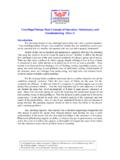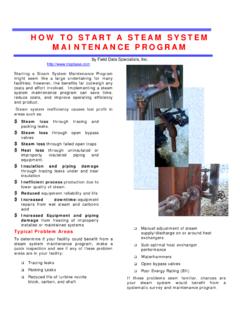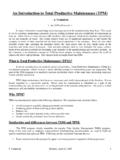Transcription of Organising the Plan for Turnarounds - plant-maintenance.com
1 Organising the Plan for Turnarounds From Petroleum Technology Quarterly, June 2001 By Rod Oliver, Meridium, Inc. In the preparations for any turnaround, a work process must be a part of the company s overall business plan, says the author, so that it takes into account the changing business environment as well as developments in the plan itself. Most organisations recognise that a turnaround is no longer a single occurrence that is simply part of the maintenance function. It is readily accepted there is a need for multi-functional teams to be responsible for planning, and for a work process the organisation is able to follow throughout these high cost activities.
2 However, definition of the work process can be a challenge. The solution for many organisations has been the adaptation of a generic process to their local environment. In theory, and fortunately in practice, a good generic process is capable of being applied to the overhaul of a multitude of different types of plant and equipment, irrespective of the nature of the industry. The 80/20 rule is well known; however, if a sound generic process is being applied then many are surprised to discover that the fit is more like 90/10. A common mistake is simply to classify Turnarounds as just other projects . It is true that they have many things in common with all projects, but typically the nature of repair work sets it apart.
3 Despite the considerable improvement in the techniques for predicting the condition of equipment, there remains that element of discovery when the equipment is opened and cleaned for inspection. A further difference is that the execution of the turnaround tends to be more concentrated than for construction projects. It has its own challenges of having to make instant decisions based on the equipment condition as found, despite the increasing accuracy of predicted conditions and corrosion rates. Therefore, the work process for planning the turnaround needs to address the specific needs and challenges that are part of repairing continuous process equipment.
4 The first step in defining a process is to recognise that it is in fact ongoing, with the completion of one turnaround being the starting point of the next cycle. Returning the plant to production with on spec products going to tankage is often seen as the point at which demobilisation of people and equipment takes place. While this is certainly true for the majority of the workforce, those who make up the planning team must remain in place to ensure that records are completed and that lessons learned are carried forward to the next turnaround. Any work process must be a part of the overall company business plan, to ensure that it reflects the current needs of the constantly changing business environment.
5 It should also recognise that the focus of planning activities will change depending upon the stage reached in the planning process. The first reaction of many is that the work process, starting as it does immediately after completion of the last turnaround, will require considerably more effort and planning manpower than if planning did not start until nearer the actual turnaround dates. This is not necessarily the case. If we assume that a given number of activities need to be accomplished in the planning process, it is often more efficient to carry them out over a longer period of time rather than rushing to complete them in the few months immediately prior to the turnaround.
6 As previously mentioned, the need for multi-functional or disciplined teams (core team) to handle the diverse activities of the planning process is generally recognised as a practical means of ensuring that the disparate requirements of all those who contribute to the turnaround are reflected in the final plan. What is not always recognised is that such teams require both leadership and guidance and that working as a team raises it own challenges. We should not be surprised that self directed teams often proceed in self directed directions and that these can be in conflict with corporate or plant requirements.
7 Many organisations provide guidance to such teams through a steering committee to oversee their progress and to ensure that their efforts are channelled down the right path. Additionally, they can easily be kept abreast of corporate, managerial and operational decisions that will influence specific Turnarounds . The core team The appointment of a core team to handle the planning process is often considered as an end in itself, but really this is just the first step. Working as a member of a team does not always come naturally to individuals who traditionally have had roles and responsibilities that were based on functional and departmental requirements.
8 When naming members of a core team, an assessment of their ability to work as a team should be made and, where needed, appropriate training should be given. However, it should not be assumed that everyone can be taught the skills that are needed to be an effective team member. Simply put, not everyone is suited to being a team player. This should not imply that they are ineffective, but rather that their individual talents are best utilised outside a team environment The challenge does not only lie with team members. Frequently, those who appoint individuals to the team have difficulty in delegating authority along with the responsibility.
9 This "pass everything by me" symptom is often difficult to break, but it is essential to do so if the team is to be effective. Make certain that team members clearly understand that decisions are made by the team and not by individuals within it. Frequently overlooked is the need to define the roles and responsibilities of the core team and its members. Roles will fall into two categories, those that are common to all members and those that are dependent on the individual functionality of the team member. The core team must have a functional leader or facilitator whose responsibility it is to assess timing for issues that need resolution, to ensure that meetings are scheduled, and that links with the steering committee are maintained.
10 This assignment can vary with the type of turnaround being planned or on the basis of the stage of the process. In some organisations, operations department representatives will lead the team until the pre-shutdown work is started, whereupon the maintenance representative will take the lead. Steering committee The members of the turnaround steering committee team will be the facility s senior management. The obvious purpose of such a group is to provide direction and guidance to the core team and ensure that the turnaround meets the needs of the business. However, the more important function of the committee is to ensure that the scope and budget for the turnaround are in alignment.















